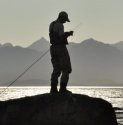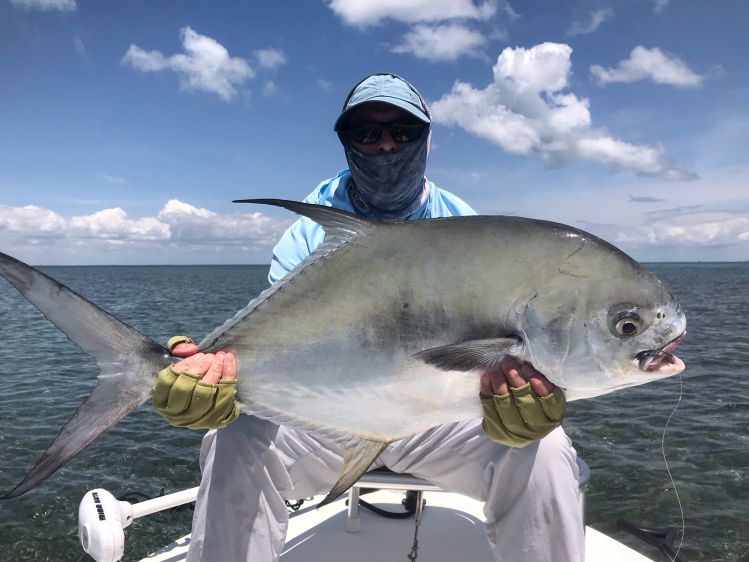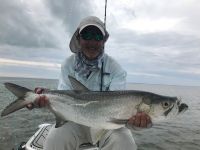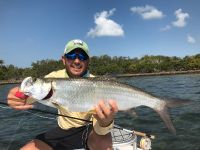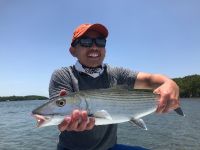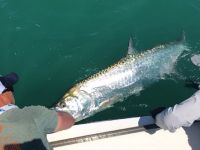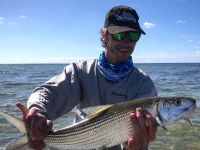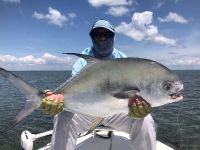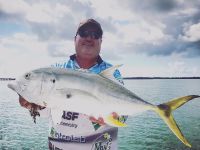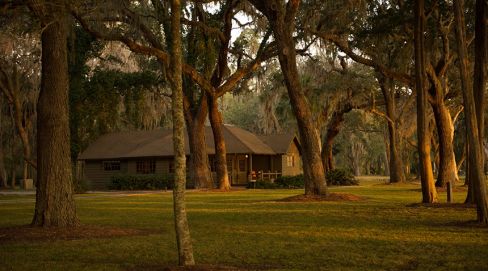My dad and grandpa took me and my brothers fishing when we were little kids to Patagonia so I started fly fishing when I was 5 or 6 years old. I never stopped.
Fd: When did fly fishing turn into a steady job for you?
My long time dream was to be able to fish for a living so in 2001 when Argentina went on default I was offered a job in the US. I took it and at the same time I started building a lodge on the banks of my home river in Patagonia so I started officially guiding and hosting trips at my lodge in 2002.
Fd: How did you get into saltwater fly fishing?
I went to college in Miami in the ‘80’s and we used to fish Biscayne bay from shore. I fished the ocean sometime in the 90’s in Uruguay for Corvina rubia y negra (blonde and black drum) and caught a few. When I moved back to the USA (Boston) I started fly fishing for stripers and loved it but it was too cold so I moved to Miami and fell in love with the area and sight fishing. It was so difficult and different that I tried and tried, and keep trying….
Fd: Please tell us more about your early days guiding in the Everglades National Park and Biscayne Bay.
I was fortunate enough to have met and fished with Captain Bill Curtis. I had no idea what I was doing, all I knew was that I wanted to catch a bonefish. It was the mystique of sight fishing in clear water for those speedsters that obsessed me.
I had no boat so I had to walk and wade. All the information I had was from books and magazine articles. I remember devouring Randall Kaufman’s bonefish book and reading the great Joe Brooks books about bonefish and tarpon but that was all I had.
It was strange to find a very tight lipped fly fishing community in Miami and Keys. I lived in Patagonia in a small town and we all knew each other, it was an unspoken rule between fly fishermen to share our “secrets” and spots, like go to such and such pool and use this or that fly with this fly line…. Or you went to the local fly shop and the owner would tell you the spot, the fly, the line and everything you needed to know to catch a fish while here in SE Florida not even the guy at the fly shop would tell you what to do, so it was all trial and error. My first year I caught ONE bonefish, the second year I caught 2 or maybe non, LOL.
Until I met Capt. Bill. He showed me how it was done in Everglades National Park first and taught me how to read tides and local fish behavior according to said tides and so on. We fished a couple times in Biscayne bay and he taught me how to look for bonefish and permit and how to fight a big Tarpon and win (I mostly lost).
The beauty of saltwater fly fishing is that there are so many variables that you never stop learning. Every day out there is different and you have to put your brain to work if you want to succeed.
Fd: These areas hold a great reputation in the sport of fly fishing. Can you explain this to those who haven't been there yet?
I remember the first fly fishing book I read. FLY FISHING by Joe Brooks. His stories on fly fishing in Florida were my favorites and always wondered if the place could be as good as the stories he told. He was right. SE Florida is in my humble opinion the best saltwater place on earth, period. Why? You can fish year round regardless of weather and catch the fish of a lifetime. Biscayne bay, right in front of Miami has the biggest tarpon, bonefish and permit in the world. Sure, you can go to the Yucatan and have more shots to permit or to the Bahamas and have more shots at easier smaller bonefish and so on but here, we have them all together and then a lot more species, all right here at our front porch, no passport needed.
It is a strange feeling when we leave the ramp and leave a huge metropolis behind and all we see are the faraway keys we are heading to knowing we’ll see that trophy fish to cast our flies to.
And then you have Florida bay (Everglades National Park) which despite us humans trying to make everything in our greedy powers to deplete the planet from natural resources and wasting all the precious spring water flow, gives us year after year of use and abuse, SPECTACULAR fishing for tarpon, redfish, snook, speckled sea trout, triple tail, jacks, mackerel, ladyfish, grouper, snapper, etc etc etc.
I know we are talking fishing here, but once you fished a bit and start to chillax you widen your angle of vision and find an incredible habitat full of life. Suddenly you see a herd of manatee feeding on turtle grass and around them schools of trout, jacks and other opportunistic feeders, you see a school of permit following a large nurse shark, flocks of migratory birds, bottlenose dolphin, huge sawfish and coral reefs. It is amazing.
Fd: When should clients visit you to fish the prime time? How long before should they contact you?
We are blessed with excellent fishing conditions year round but most people consider PRIME TIME the months of APRIL-MAY-JUNE-JULY when the big tarpon migration is in full swing. These are the months when you catch tarpon over 100 lbs. in super shallow crystal clear water. I am talking real 100 + lb. fish, not Facebook weights. These are the months when if you are a fan of huge tarpon you will have lots of shots at them, sight fishing version of Formula one racing. Guides are booked usually booked a year in advance for these particular dates.
I have 3 PRIME TIMES:
- The mentioned Tarpon season.
- Grand slam and variety season March to September (Bonefish, tarpon, permit, jacks, barracuda, seatrout, redfish, cobia, triple tail, snook, black drum, etc.).
- WINTER (January and February fishing in the Everglades is fantastic).
Fd: What is the recommended gear for these trips?
You don’t need to bring anything to fish with me but if you fish on your own or just want to use your gear I recommend 8 – 10 and 12 wt. rods (or 7-9-11) with matching reels. You can add a smaller weight rod if you want to catch a lot of different species in one day.
7/8 rods for bonefish, redfish, snook, macks, etc.
9/10 rods for tarpon up to 50 lbs., Mahi, Sharks, grouper.
11/12 rods for Big tarpon and sharks.
The lines we use are floating and floating with clear intermediate tip. Under certain conditions and species targeted we might use a full intermediate or even a 300 to 400 grain line.
I use 10’ to 15’ leaders on floating lines, 7’ to 9’ for clear tips and 4-5’ with full intermediate or sinking lines.
Fd: Can you describe the programme for a typical day out?
We’ll meet at the ramp at the scheduled time and fish for the day. Usually if the client fishes just one day and wants to catch fish we’ll meet at 7.30 am and fish to around 4 pm.
We will go to different spots depending on species and tides. It is all about the tides. Some people want a particular specie and some others just want to have fun. Communication between angler and guide is very important so the guide can plan the day accordingly. Sometimes plans go down the drain due to unforeseen factors that may alter our plan so it is important to be flexible to adapt and have fun regardless.
For the angler that comes for a couple days and wants to fish just for say Tarpon, we might meet earlier or later depending on the tides and weather conditions. We may even split the day in 2 sessions fishing the best tides (we have two incoming and two falling tides per day in SE Florida).
Fd: Any other word of advice for those visiting you?
My biggest advise is, as is anything else in life if you want to succeed, is to PRACTICE , in this case casting. Sometimes it is difficult due to busy work or family schedule but if you can do it, you will have better chances to succeed in your goal of catching that particular fish you are after. You don’t need to cast super long but you have to cast up to 50 feet with as few false casting as possible and put that fly on 3 sq. ft. in front of the fish.
Your guide will put you in casting position as soon as possible and provide you with the best gear but you still have to put that fly right there pretty quick.
Also once you spot the fish, never take your eyes away from him to cast or you will lose him, and listen to your guide.
Fd: After all these years, what does fly fishing mean to you?
Fly fishing means a lot of things to me. It connects me to my childhood, to my late Dad and Grandpa. It takes me to beautiful places outside and inside. It is my job and I love it.
Visit Martín Carranza's Travel profile for questions and bookings, right here: Travel.
You don’t need to bring anything to fish with me but if you fish on your own or just want to use your gear I recommend 8 – 10 and 12 wt. rods (or 7-9-11) with matching reels. You can add a smaller weight rod if you want to catch a lot of different species in one day.
7/8 rods for bonefish, redfish, snook, macks, etc.
9/10 rods for tarpon up to 50 lbs., Mahi, Sharks, grouper.
11/12 rods for Big tarpon and sharks.
The lines we use are floating and floating with clear intermediate tip. Under certain conditions and species targeted we might use a full intermediate or even a 300 to 400 grain line.
I use 10’ to 15’ leaders on floating lines, 7’ to 9’ for clear tips and 4-5’ with full intermediate or sinking lines.
Fd: Can you describe the programme for a typical day out?
We’ll meet at the ramp at the scheduled time and fish for the day. Usually if the client fishes just one day and wants to catch fish we’ll meet at 7.30 am and fish to around 4 pm.
We will go to different spots depending on species and tides. It is all about the tides. Some people want a particular specie and some others just want to have fun. Communication between angler and guide is very important so the guide can plan the day accordingly. Sometimes plans go down the drain due to unforeseen factors that may alter our plan so it is important to be flexible to adapt and have fun regardless.
For the angler that comes for a couple days and wants to fish just for say Tarpon, we might meet earlier or later depending on the tides and weather conditions. We may even split the day in 2 sessions fishing the best tides (we have two incoming and two falling tides per day in SE Florida).
Fd: Any other word of advice for those visiting you?
My biggest advise is, as is anything else in life if you want to succeed, is to PRACTICE , in this case casting. Sometimes it is difficult due to busy work or family schedule but if you can do it, you will have better chances to succeed in your goal of catching that particular fish you are after. You don’t need to cast super long but you have to cast up to 50 feet with as few false casting as possible and put that fly on 3 sq. ft. in front of the fish.
Your guide will put you in casting position as soon as possible and provide you with the best gear but you still have to put that fly right there pretty quick.
Also once you spot the fish, never take your eyes away from him to cast or you will lose him, and listen to your guide.
Fd: After all these years, what does fly fishing mean to you?
Fly fishing means a lot of things to me. It connects me to my childhood, to my late Dad and Grandpa. It takes me to beautiful places outside and inside. It is my job and I love it.
Visit Martín Carranza's Travel profile for questions and bookings, right here: Travel.

